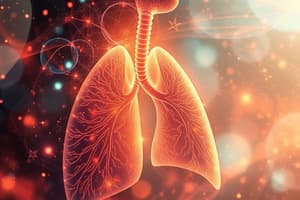Podcast
Questions and Answers
Which respiratory disorder is characterized by a chronic inflammatory disease resulting in narrowing of airways?
Which respiratory disorder is characterized by a chronic inflammatory disease resulting in narrowing of airways?
- COPD
- Pneumonia
- Asthma (correct)
- Bronchitis
What respiratory disorder is defined as an infection in the lungs that can lead to coughing, difficulty breathing, and fever?
What respiratory disorder is defined as an infection in the lungs that can lead to coughing, difficulty breathing, and fever?
- Cystic fibrosis
- COPD
- Pneumonia (correct)
- Bronchitis
Which respiratory disorder is a genetic disorder that leads to the production of thick mucus in the lungs?
Which respiratory disorder is a genetic disorder that leads to the production of thick mucus in the lungs?
- COPD
- Cystic fibrosis (correct)
- Bronchitis
- Asthma
What common respiratory disorder involves inflammation of the bronchi and can cause a persistent cough and chest discomfort?
What common respiratory disorder involves inflammation of the bronchi and can cause a persistent cough and chest discomfort?
Which group of lung diseases causes airflow obstruction and difficulty breathing?
Which group of lung diseases causes airflow obstruction and difficulty breathing?
What respiratory disorder can manifest as shortness of breath, wheezing, and chest pain?
What respiratory disorder can manifest as shortness of breath, wheezing, and chest pain?
What is one common symptom of pulmonary fibrosis?
What is one common symptom of pulmonary fibrosis?
Which diagnostic test is NOT mentioned as part of the diagnosis of respiratory disorders?
Which diagnostic test is NOT mentioned as part of the diagnosis of respiratory disorders?
What is a key preventative measure to reduce the risk of respiratory disorders?
What is a key preventative measure to reduce the risk of respiratory disorders?
Which healthcare professional is NOT mentioned as part of the management of respiratory disorders?
Which healthcare professional is NOT mentioned as part of the management of respiratory disorders?
Which lifestyle change can help reduce the risk of developing respiratory disorders?
Which lifestyle change can help reduce the risk of developing respiratory disorders?
What is a common symptom of sleep apnea?
What is a common symptom of sleep apnea?
Study Notes
Exploring the Respiratory System and Its Disorders
The respiratory system is a complex network of organs that enables us to breathe, providing our bodies with the oxygen we need to function and removing waste gases like carbon dioxide. This system consists of the nose, nasal cavities, pharynx, larynx, trachea, bronchi, and lungs, which are all connected to form an intricate pathway for air to flow through the body.
Respiratory Disorders
Respiratory disorders are conditions that affect the normal functioning of the respiratory system. These disorders can impact our ability to breathe, resulting in symptoms such as shortness of breath, coughing, wheezing, and chest pain. Some of the most common respiratory disorders include:
-
Asthma: This chronic inflammatory disease results in narrowing of airways, which causes difficulty breathing and tightness in the chest.
-
Chronic obstructive pulmonary disease (COPD): A group of lung diseases, including chronic bronchitis and emphysema, that cause airflow obstruction and difficulty breathing.
-
Pneumonia: An infection in the lungs that can cause coughing, difficulty breathing, and fever.
-
Bronchitis: Inflammation of the bronchi, which can lead to a persistent cough, wheezing, and chest discomfort.
-
Cystic fibrosis: A genetic disorder that causes the production of thick mucus in the lungs, which can lead to chronic respiratory infections and lung damage.
-
Pulmonary fibrosis: A condition in which the lung tissue becomes scarred, leading to reduced lung function and shortness of breath.
-
Lung cancer: A malignant growth in the lung that can cause a persistent cough, chest pain, and fatigue.
-
Sleep apnea: A sleep disorder characterized by pauses in breathing during sleep, which can lead to excessive daytime sleepiness and other health complications.
Diagnosis, Treatment, and Management
Early diagnosis and appropriate treatment are essential to improve outcomes for patients with respiratory disorders. Diagnosis often involves a combination of medical history, physical examination, and various tests, such as spirometry, chest X-rays, and blood tests.
Treatments for respiratory disorders can include medications, such as inhalers, oral medications, or antibiotics; physical therapy; and lifestyle changes, such as quitting smoking, eating a healthy diet, and getting regular exercise. In some cases, surgical interventions may be necessary, such as lung transplantation for severe pulmonary fibrosis or lung cancer.
Management of respiratory disorders typically involves working with a team of healthcare professionals, including doctors, respiratory therapists, and nurses, to develop an individualized treatment plan that addresses the specific needs and concerns of each patient. Regular follow-up appointments are essential to monitor progress and ensure that treatment plans remain effective.
Prevention and Risk Factors
Preventative measures can help decrease the risk of developing respiratory disorders. Some of the most important prevention strategies include:
-
Avoiding tobacco smoke exposure: Smoking cessation and avoiding secondhand smoke are crucial to reducing the risk of respiratory disorders.
-
Maintaining a healthy weight: Obesity can increase the risk of developing respiratory disorders, so maintaining a healthy weight is important.
-
Eating a healthy diet: Nutrient-rich foods can support a strong immune system and overall health, which can help prevent respiratory infections.
-
Staying active: Regular physical activity can help improve lung function and overall health, which can reduce the risk of developing respiratory disorders.
-
Washing your hands: Regular handwashing and practicing good hygiene can help prevent the spread of respiratory infections.
By understanding the basics of the respiratory system and its disorders, as well as the importance of prevention, diagnosis, and treatment, we can work together to improve respiratory health and wellbeing.
Studying That Suits You
Use AI to generate personalized quizzes and flashcards to suit your learning preferences.
Description
Delve into the complexity of the respiratory system and common disorders affecting it, such as asthma, COPD, pneumonia, and lung cancer. Learn about diagnosis methods, treatment options, preventative measures, and the importance of early intervention for respiratory health.




